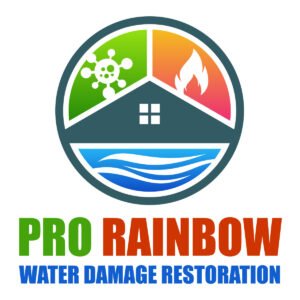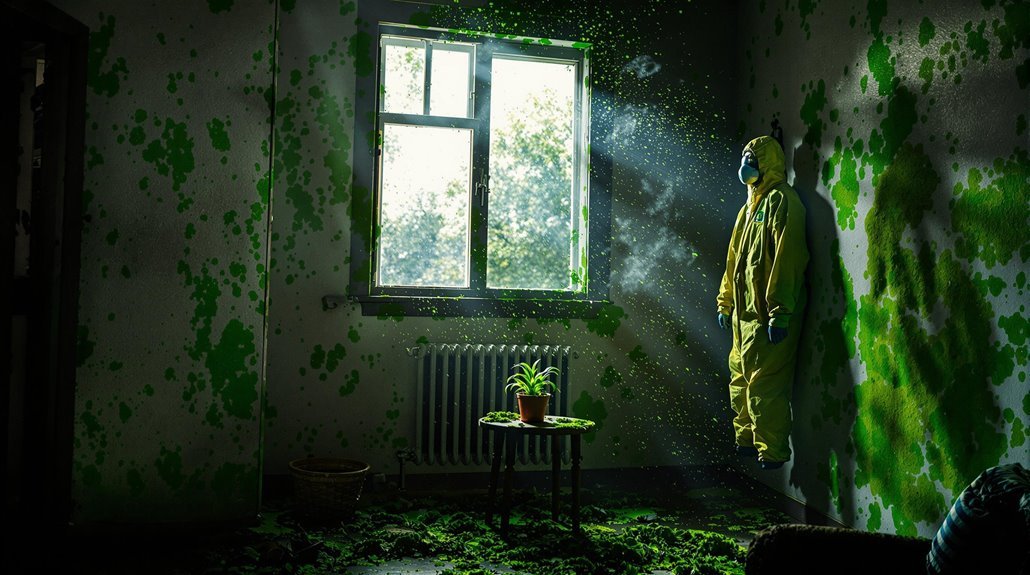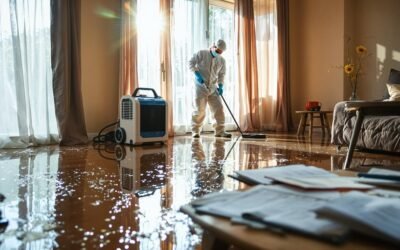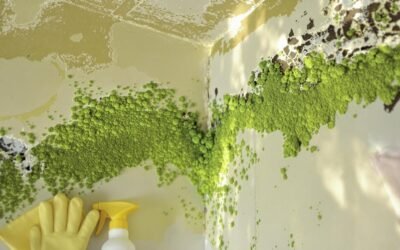Staying in your house with green mold isn't safe because of its potential health risks. Mold can cause respiratory issues, allergic reactions, and aggravate pre-existing conditions like asthma. If you notice significant growth, consider conducting a mold inspection and temporarily evacuating if symptoms worsen. It's vital to identify and address moisture sources to prevent further mold development. Use protective gear during cleanup, and thorough cleaning is important. Professional remediation services might be necessary for extensive infestations. Understanding mold management will help you maintain a healthier living environment and protect your well-being moving forward.
Key Takeaways
- Evaluate the extent of green mold growth; significant infestations may require temporary evacuation for safety.
- Wear protective gear, including masks and gloves, to minimize health risks during mold exposure.
- Seek professional help for extensive mold issues, as they can provide effective remediation and minimize exposure.
- Improve ventilation and control humidity levels to reduce mold growth and associated health risks in the home.
- Monitor for symptoms like coughing or sneezing; if they worsen, consider leaving the home until mold is addressed.
Understanding Green Mold
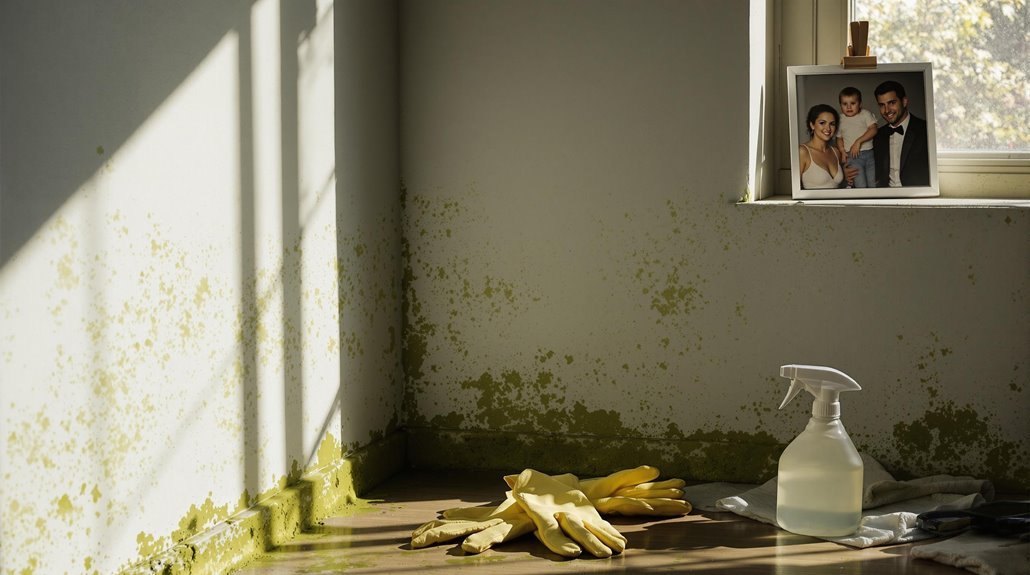
While you may associate mold with unsightly patches in damp corners, understanding green mold is fundamental for maintaining a healthy environment. Green mold refers to various mold types, including Cladosporium and Penicillium, which thrive in moisture-rich conditions. Accurate mold identification is imperative for effective remediation. You can often spot green mold by its distinctive color and texture, typically appearing as fuzzy or velvety growths on surfaces. Identifying the specific type of mold can guide your response, as some are more resilient than others. Regularly inspecting your home for moisture issues and mold growth is critical. By taking proactive measures, you can manage mold effectively and guarantee a safer living space. Remember, knowledge is your best ally in combating mold. Additionally, addressing common causes of mold is essential for preventing future growth and ensuring a healthier home environment.
Health Risks of Mold Exposure
Exposure to green mold can lead to significant health risks, particularly respiratory issues and allergic reactions. When inhaled or contacted, mold spores may trigger symptoms like coughing, sneezing, or skin irritation. Understanding these potential health effects is essential for managing your environment and protecting your well-being. Additionally, professional restoration services can help mitigate mold exposure and ensure a safe living space.
Respiratory Issues
Mold can pose serious respiratory risks, especially for individuals with pre-existing conditions like asthma or allergies. When exposed to mold, you may experience various mold symptoms, including coughing, sneezing, or nasal congestion. These symptoms can escalate into more severe issues like breathing difficulties, particularly in those with compromised respiratory systems. Even if you're healthy, prolonged exposure can still lead to respiratory irritation and chronic conditions over time. It's essential to monitor your environment and address any mold growth promptly. If you notice mold in your home, consider removing it and improving ventilation to minimize exposure. Staying vigilant about mold in your living space can help protect your respiratory health and overall well-being.
Allergic Reactions
Allergies can worsen considerably due to mold exposure, especially for those already prone to allergic reactions. When mold spores enter your environment, they can trigger a heightened immune response. This reaction can lead to various allergy symptoms, such as sneezing, nasal congestion, and itchy eyes. For individuals with asthma or other respiratory conditions, these symptoms may escalate, causing difficulty in breathing or severe reactions. It's crucial to recognize that even low levels of mold can provoke significant allergic responses. If you notice these symptoms worsening in your home, it's critical to address the mold issue promptly. Ignoring mold can lead to prolonged exposure, intensifying your allergic reactions and potentially impacting your overall health.
When to Leave Your Home
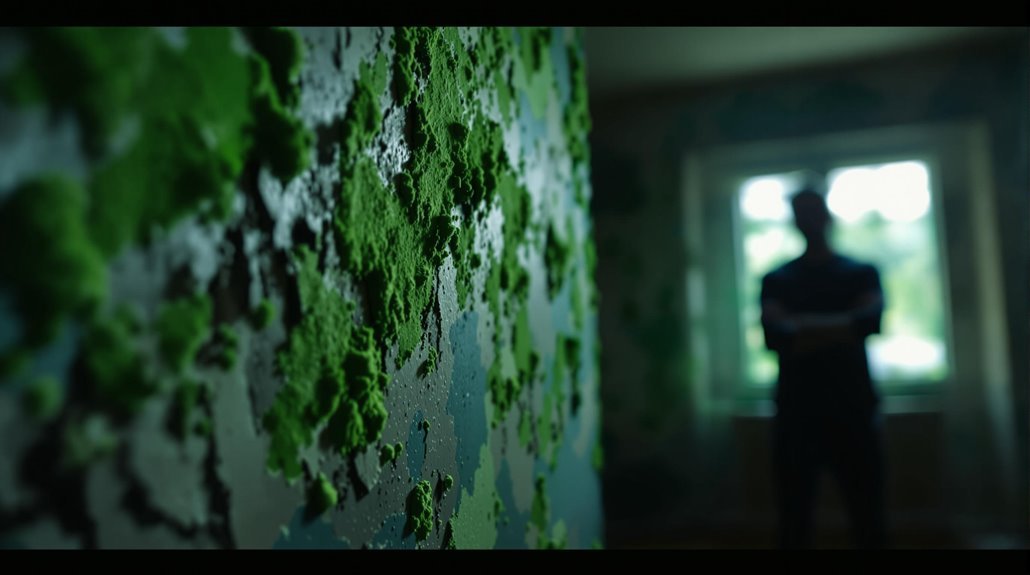
If you notice a significant increase in green mold growth within your home, it's crucial to assess the situation carefully. First, conduct a mold inspection to determine the extent of the problem. If the mold covers a large area or you experience worsening health issues, consider leaving your home temporarily. Evacuation procedures should be implemented if you or your family members have severe allergic reactions or respiratory problems. Furthermore, if the mold exposure becomes overwhelming, prioritize your health by finding alternative accommodations until the issue is resolved. Remember, it's better to err on the side of caution. Always consult professionals to verify your home is safe before returning. Your well-being should be your top priority.
Safety Tips for Managing Mold
To effectively manage mold, you need to identify its sources, such as leaks or high humidity areas in your home. Using protective gear like gloves and masks is essential to safeguard your health while addressing the issue. By taking these steps, you can minimize exposure and begin the process of mold remediation safely.
Identify Mold Sources
Identifying mold sources is crucial for effective management and prevention. Start by inspecting areas with high moisture sources, such as bathrooms, kitchens, and basements. Look for water leaks, condensation, or damp materials that can support various mold types, including green mold. Pay attention to hidden spots like behind walls or under carpets, where moisture can accumulate unnoticed. Keep an eye out for discoloration or a musty smell, as these can indicate mold presence. Once you pinpoint the moisture sources, you can address them to prevent further mold growth. Regularly check your home's ventilation and humidity levels to create an environment less favorable to mold. Staying proactive is key to maintaining a healthy living space.
Use Protective Gear
Protective gear is vital when managing mold, especially green mold, to safeguard your health. When you're dealing with mold removal, wearing protective masks is fundamental to prevent inhaling spores that can cause respiratory issues. Choose a mask rated N95 or higher to guarantee adequate filtration. Furthermore, don't overlook the importance of safety goggles. These will protect your eyes from mold particles and potential irritants in cleaning solutions. It's wise to wear long sleeves and gloves to minimize skin exposure. By using the right protective gear, you markedly reduce your risk of health complications associated with mold exposure. Always prioritize safety to assure a successful and healthy mold remediation process in your home.
Cleaning and Remediation Options
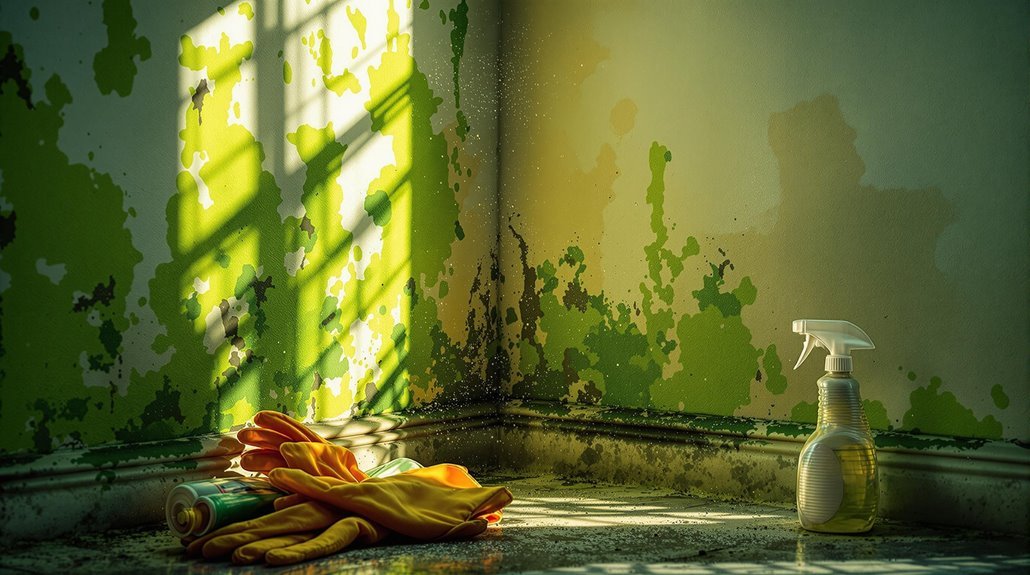
While green mold can pose health risks, effective cleaning and remediation options are available to tackle the issue. Start with thorough cleaning techniques, using a mixture of water and detergent to scrub affected surfaces. For more persistent mold, consider specialized cleaning solutions containing mold inhibitors. After cleaning, confirm that the space is well-ventilated to aid drying.
If the mold persists or covers extensive areas, you might need professional remediation methods. These experts can assess the situation and use industrial-grade equipment to remove mold safely. They can as well identify underlying moisture issues contributing to mold growth. Remember, addressing both the mold and its source is vital for effective remediation, guaranteeing your home is safe and healthy.
Preventing Future Mold Growth
To effectively prevent future mold growth, it's essential to control moisture levels in your home. Keeping humidity low and guaranteeing proper ventilation can make a significant difference. Consider using mold resistant materials during repairs or renovations, as they can greatly reduce the risk of mold development.
Here are some practical tips to improve moisture control:
- Use dehumidifiers in damp areas like basements.
- Regularly inspect and repair leaks in plumbing and roofs.
- Confirm proper ventilation in kitchens and bathrooms.
- Maintain a consistent indoor temperature to prevent condensation.
Conclusion
In summary, while it may be tempting to stay in your home with green mold, it's essential to prioritize your health. Mold can pose serious risks, so if you notice extensive growth, consider relocating temporarily. Addressing the issue promptly with proper cleaning and remediation is critical to guarantee your safety. Remember, just like a smartphone needs updates to function properly, your home needs regular maintenance to prevent mold. Stay vigilant and keep your living space healthy.
